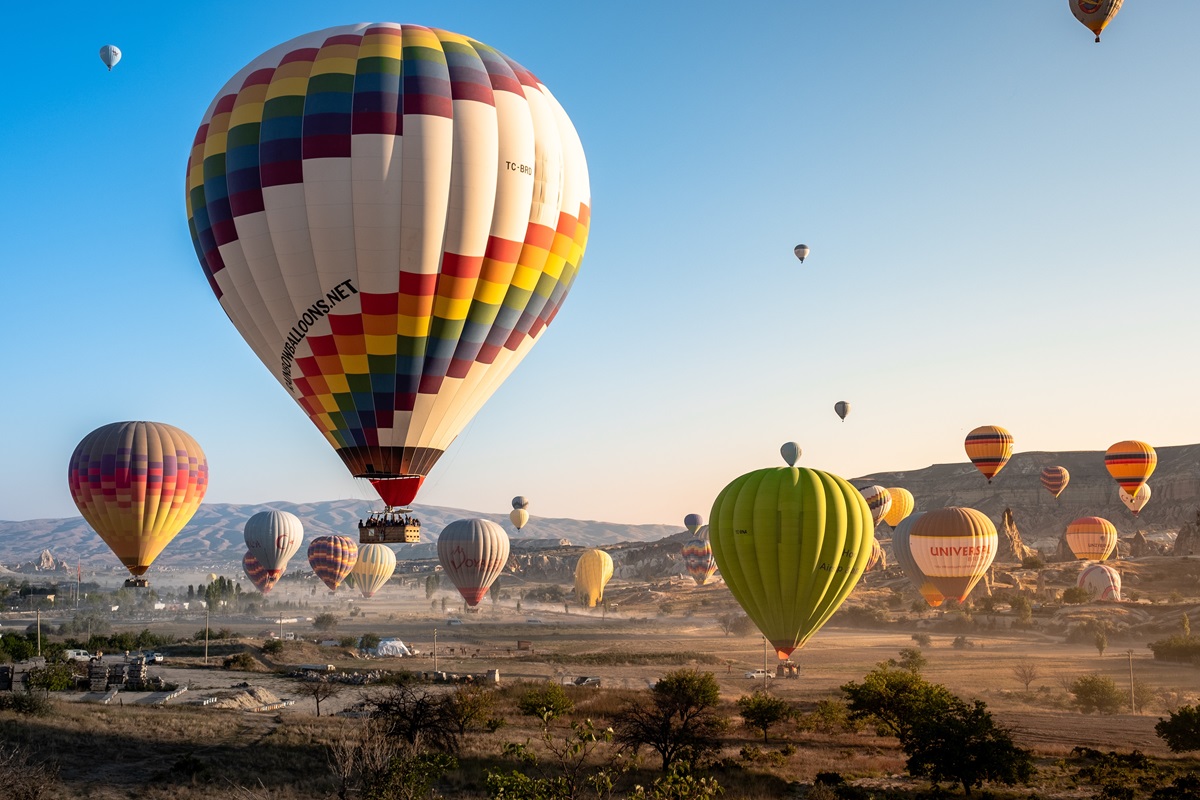Julie Beun was unsure about hot air ballooning, until she took to the skies and discovered a whole new way of viewing the world
By Julie Beun
Standing in an open field south of Ottawa on an autumn morning in the pre-dawn darkness, my friend Janet leans close and whispers in my ear.

“My knees are knocking. I can’t stop my legs from shaking.”
I look at her face, lit only by headlights from a nearby chaser vehicle. She looks as nervous as she sounds.
“Don’t worry,” I whisper back. “This is a daring adventure. We’ll love it.”
The “it” in question was lying flaccid on the ground beside us, but rapidly growing as it was filled with regular blasts of hot air from a propane furnace.
 In no time, the massive hot air balloon that was to be our airborne adventure for the next 57 minutes was filled and ready to float. Sundance Balloons pilot Jack Wismer stepped into the glow of the vehicle lights.
In no time, the massive hot air balloon that was to be our airborne adventure for the next 57 minutes was filled and ready to float. Sundance Balloons pilot Jack Wismer stepped into the glow of the vehicle lights.
“OK, time to move, folks! Everybody in! Just like we practiced!”
Five minutes later, 14 strangers launched silently off the ground, floating above trees before heading out over the Rideau River.
“Oooh,” Janet said, a slow smile blooming. “Oh, this is really incredible.”
And so it was. A sliver of orange light started to crest on the horizon to the east, illuminating endless fields broken up with stands of forest, roads crosshatching the landscape and grain silos.
The view, as the sun rose, was breathtaking. Ten minutes into the flight, we were already talking about if we’d do it again.
Judging by the growing popularity of hot air balloon tourism worldwide, it’s a common enough conversation amongst first-time fliers eager to return to the skies.
From Türkiye to Quebec and Arizona to Australia, hot air ballooning has taken off in the form of festivals, some of which see up to 500 balloons simultaneously aloft in a dazzling display of colour in flight.
And once you’ve been to one festival, it’s hard to stay away, says Jack, who has spent the past seven years at the helm of balloons.
After being part of a chaser vehicle crew as a London, ON, high school student in the late ’90s, he caught the bug, but couldn’t see a future in it.
 “It was fantastic, I was always fascinated by it, but they weren’t really training pilots, so I went off and did other things. It was seasonal, weather dependent and split shifts, so it wasn’t really a career.”
“It was fantastic, I was always fascinated by it, but they weren’t really training pilots, so I went off and did other things. It was seasonal, weather dependent and split shifts, so it wasn’t really a career.”
A few years later, he found himself living in Montreal when a pilot he knew invited him to the world-famous Albuquerque International Balloon Fiesta in New Mexico. Since 1972, the festival has hosted 500 balloons and thousands of fans every October, when desert conditions are near perfect.
“I told my boss, I’m taking three weeks off and if there’s a job when I come back, great, but I’m not missing this opportunity. When I was there, I realized how much bigger it was than just in Canada. I thought, hey, I could make this a career.”
Up in the air over Ottawa, as we glided over late summer crops and gasped in delight at spotting a fox dashing for cover or horses prancing as we came into view, Jack was the right blend of professional skill and lighthearted humour.
“When did I start piloting?” he responded straight-faced to a query. “Well, last night I watched some YouTube videos on how to take off, but ran out of data before I got to how to land.”
The wisecrack dispelled any anxiety that lingered from the knowledge that we were floating hundreds of feet in the air in a wicker basket. Even as we prepared to land, his remark that it “might be a rock ’n roll landing” just elicited a murmur. After a marvellous 57 minutes in the air travelling 30 kilometers from Dilworth Road to South Mountain, a minor bump on landing was nothing.
Later, after pitching in to pack the balloon in the trailer, Jack and his crew popped open a bottle of sparkling wine, made a traditional toast and explained why we were all drinking in a farmer’s field before breakfast.

In 1793, the first manned flight by French brothers Joseph and Etienne Montgolfier (after whom the balloons are named in French) lasted all of 20 minutes, but started a centuries-long fascination with flight.
Before long, the novelty caught the attention of King Louis XVI, who wanted his fashionable court at Versailles to see a flight. Up went a balloon with a duck, sheep and cockerel in the basket, which so impressed the regent, he instantly adopted the animals to his royal menagerie and gave the new science his blessing.
But when hot air balloons belching smoke and flames began landing in the fields of terrified provincial farmers, the pilots made peace by offering champagne with the king’s seal to the landowners.
In South Mountain, our landowner came bumping over his field in a fiery red pickup, his round face alight with delight.
“We were watching you from the barn, I’ve seen you land in other fields, but I was hoping one day you’d land in mine!”
Unlike his predecessors, he waved off the bubbly—“I have to get back to the barn”—but was thrilled to have finally hosted a hot air balloon in his soybeans.
Worldwide hot air balloon festivals
If you want to witness the beauty of hot air balloons, but prefer to be on terra firma, there are plenty of international festivals to visit.
- Cappadocia Balloon Festival, Türkiye. The 160 balloons at the festival are great, but the backdrop of the region’s iconic cone-shaped formations made it viral. The festival occurs in mid-August.
- International Balloon Festival of Saint-Jean-sur-Richelieu, QC. Home to Canada’s largest balloon festival, which features decadent food, children’s entertainment and an agricultural component.
- Albuquerque International Balloon Fiesta, N.M. Held annually in October, this is a nine-day ballooning extravaganza.
- Bristol International Balloon Fiesta, U.K. Established in 1979, this festival attracts 500,000 visitors every August.
- Canberra Balloon Spectacular, Australia. Every March, Australia’s national capital hosts 50 balloons as part of Enlighten, a larger outdoor and arts festival.
- Saga International Balloon Fiesta, Japan. Attracting 800,000 visitors to view more than 100 balloons, the Saga is held every November in Saga Prefecture.
- Gatineau Balloon Festival, QC. The National Capital Region hosts its own balloon festival (Aug. 29-Sept. 2, 2024) featuring an RV park, a fleet of balloons and a live music festival.
How safe is it?
Hot air balloon pilots—called aeronauts—undergo years of training and instructor-guided flights before they can be certified and licensed by Transport Canada. What’s more, flights only take place in optimal conditions. Unlike planes and helicopters, balloons only go up when conditions are perfect, at sunrise or sunset when wind is unlikely to send a flight off course. In fact, long before you get in the basket, your pilot and crew investigate weather patterns, wind direction and air temperature at various elevations to determine if a flight can go ahead. If a flight is cancelled, it means your safety is being taken seriously.
If you go
Follow the pilot’s instructions. Safety means abiding by best practices and Transport Canada’s rules. Skylarking, dropping things from the basket, jumping around and even arriving late for the flight are no-nos.
Wear comfy clothes. Taking off and landing in farm fields can be muddy.
Leave your personal belongings in the chaser vehicle. When landing, passengers must grab hold of the basket and spoon together to cushion any impact, making backpacks and purses an impediment. Plus, baskets are surprisingly compact, leaving little room to manoeuvre.
Lend a hand. Although not required, some balloon companies, like Sundance, invite passengers to help pack up the balloon as part of the experience. Alternatively, you can relax and wait for the champagne to pop.
There’s insurance for that. If Gene Simmons can insure his famous tongue, there’s no reason you can’t get insurance for a hot air balloon adventure. Ask about an Adventurous Air Activities Rider from CAA or your insurance provider.
Sundance Balloons, which has operated for 35 years, flies in Ottawa, Calgary, Grande Prairie, Edmonton, Winnipeg, Kitchener-Waterloo and London. sundanceballoons.com
